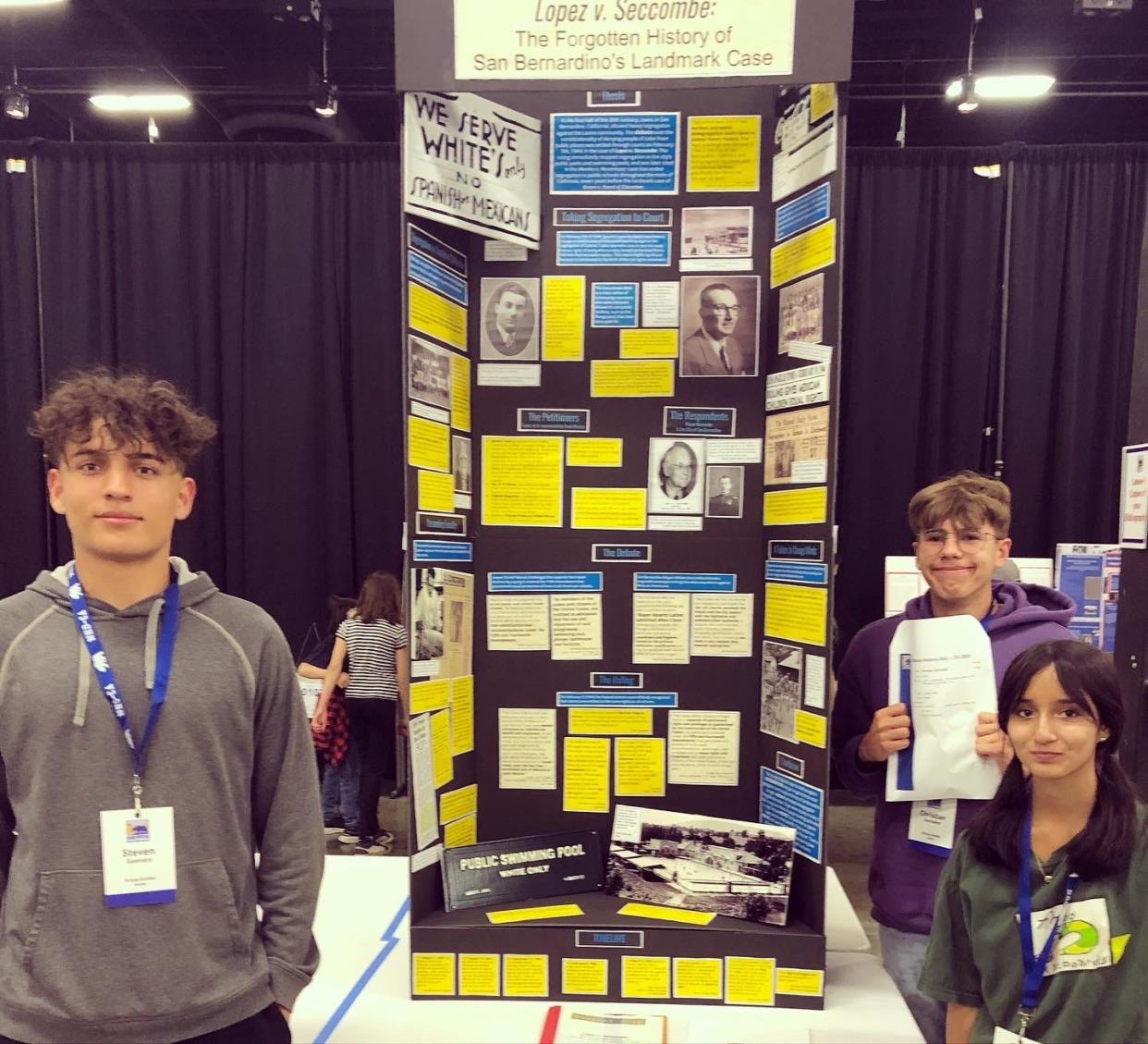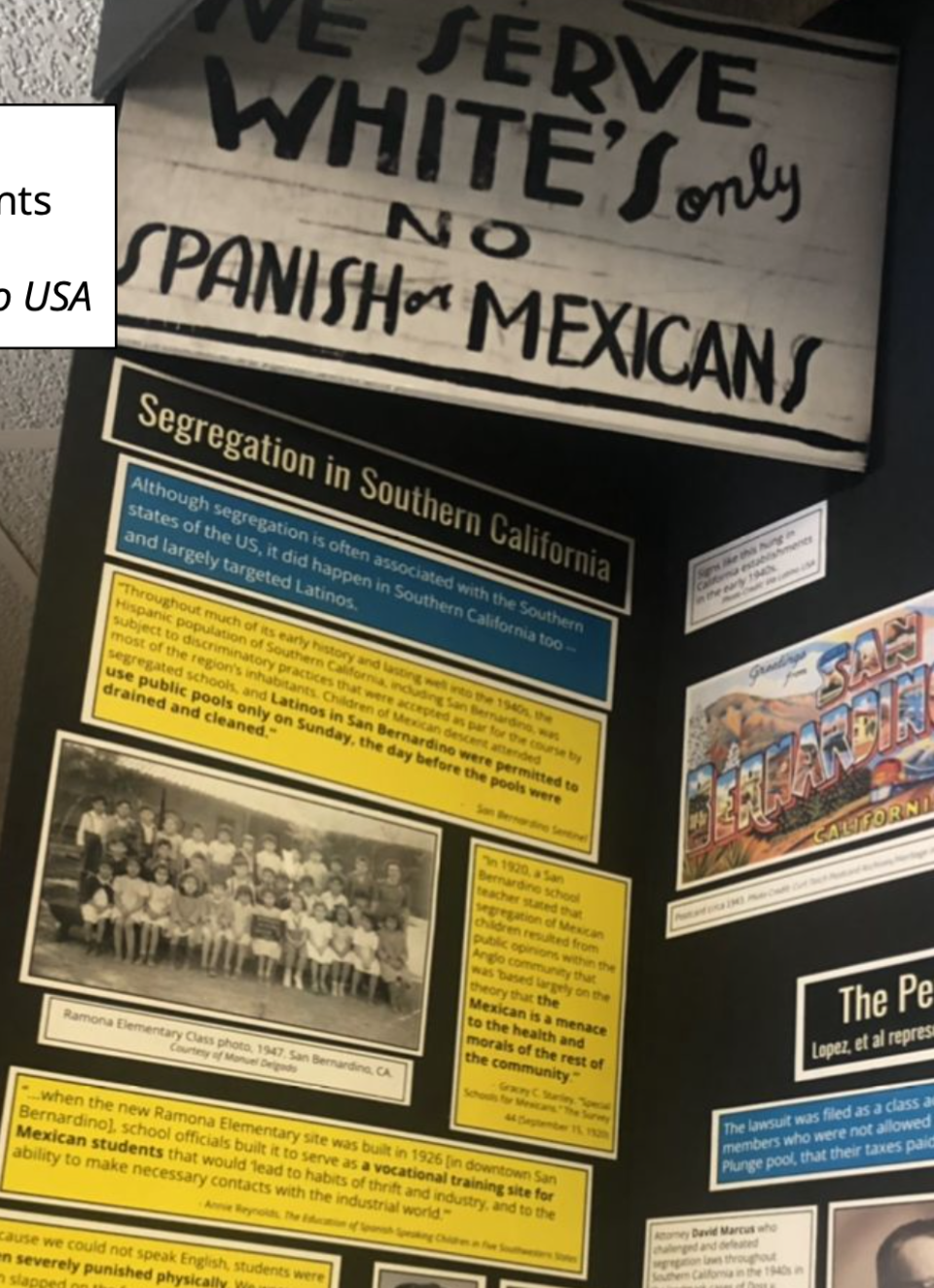Oak Hills High School students’ civil rights exhibit on ‘whites only’ case goes national

Ten years before the Supreme Court ruled that segregation in public schools was unconstitutional, Latinos won their own legal battle fighting discrimination in San Bernardino County.
The case, Lopez v. Seccombe, which desegregated public parks and pools in the city of San Bernardino, isn’t as well known as Brown v. Board of Education or other civil rights victories.
But three students from Oak Hills High School are hoping to bring more awareness to the lawsuit that they say helped spur the movement to grant equal rights to everyone.
Christian Gonzalez, Christina Godinez, and Steven Guevara are finalists in the National History Day’s National Contest.
Their work — an exhibit covering the Lopez case — is the only high school project from California being showcased virtually by the Smithsonian’s National Museum of American History and is one of the projects representing the state in the countrywide contest.
The students’ teacher, Jeni Boulanger, said it is also the first time anyone from Hesperia Unified School District has reached the national level.
Winners are scheduled to be announced on Saturday.
Boulanger's students impressed her with the amount of “digging” that went into finishing the project, which involved finding “scholarly articles and primary source newspaper articles about the case," she said.
“I am so proud to see them geek out about history and then to be recognized and rewarded on this esteemed level just make its sweeter,” she said.
The project took roughly six months of research to complete, according to Godinez, an Oak Hills senior.
Guevara, also a senior, said the group was inspired to focus on the lawsuit because there “wasn’t any coverage of the case to begin with.”
“We felt it was necessary to shed light onto this case because we have lived in this county for so long and were never taught about this time in our history,” he said.
Pool was off-limits for some

Although segregation is mostly thought of as occurring in the South, the students found it existed in Southern California as well — largely against those of Latino descent.
Establishment owners would hang signs which read “We serve white’s only — No Spanish or Mexicans.” Schools were divided by race and children who couldn’t speak English were beaten severely.
And if Latinos wanted to cool off during the heat in San Bernardino, they were turned away from public pools on all days except one: The day before the pools were to be drained or cleaned.
Fed up with the policy, the Mexican American Defense Committee in 1943 sent a letter to the City Council demanding that Mexicans be admitted to the pool at Perris Hill Park. Ignacio Lopez, an editor of a local Spanish language newspaper, El Espectador, assisted the committee.
Despite the city’s own recreation supervisor supporting the change, the City Council rejected the demands.
Lopez filed a class action lawsuit against the city and Mayor William Seccombe on behalf of all the Latino members who weren’t allowed to use public facilities.
The petitioners were represented by David Marcus, a Jewish-American lawyer who challenged other segregation laws in the state.
He argued that as Mexican Americans were taxpayers and citizens, they were entitled to use public facilities and not admitting them was in violation of their constitutional rights.
Seccombe, the mayor, in turn claimed that “cleanliness and hygiene served as the primary admission qualification and that no racial ban ever existed while had he had been mayor,” according to Mark Ocegueda, a historian cited by the students.
To test this, the Mexican American Defense Committee sent several Mexican children — neatly dressed and clean — to a city pool. The result? They were denied entry.
“They were refused the use of a swimming pool which displays a bronze plaque that says ‘no one is to be refused admittance because of race or color,’ and which was built with WPA [Works Progress Administration] money,” Lopez later wrote in his newspaper.
An influential ruling
The next year in 1944, a federal district judge handed down his decision.
Judge Leon Yankwich ruled that the city’s conduct was “illegal and (was) in violation of petitioners’ rights and privileges as guaranteed by the Constitution of the United States.”
Historian Ocegueda said Yankwich’s decision was the first time the equal protection clause of the Fourteenth Amendment had been used to uphold the rights of Mexican Americans.
Chicano civil rights movement: Before César Chávez, this Mexican woman was one of the most powerful people in US politics
The case had long-lasting impact. About three years later, judges relied on the ruling in another lawsuit which ended segregation in California schools.
The Lopez decision also influenced the Supreme Court’s landmark Brown decision in 1954, which led to the integration of public schools nationwide.
Godinez, of Latina descent, said researching the case and learning about how minorities were treated in the county made her grateful “about having rights in this day and age.
“Life was a lot more difficult, and I couldn’t imagine having my basic civil rights be taken away.”
Daily Press reporter Martin Estacio may be reached at 760-955-5358 or MEstacio@VVDailyPress.com. Follow him on Twitter @DP_mestacio.
This article originally appeared on Victorville Daily Press: Smithsonian to feature San Bernardino County desegregation fight

